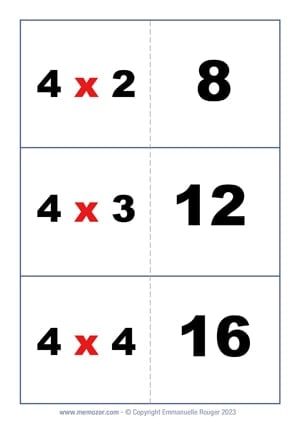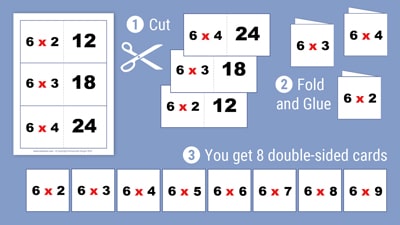Multiplication Flash Cards - 4 Times table
Practice your 4 times table with these Flash Cards. They're called "Flash Cards" because they help you memorize the multiplication tables quickly. The cards are double-sided, with the question on one side (a multiplication from the 4's table) and the answer on the other (the result of the multiplication).
The PDF contains the multiplications:
4x2, 4x3, 4x4, 4x5, 4x6, 4x7, 4x8 and 4x9
As multiplication x 1 and x 10 are very easy, we haven't included them in the PDF, it saves ink on your printer :)
Find the cards for the other times tables on our page Multiplications Flash Cards.
Click the button below to print for free the multiplications flash cards for the 4 times table and take a look at our tips below for making and using these cards.
How to make flash cards ?
Print the PDF above then glue each page to a cardboard sheet to make them more rigid and avoid transparency. Next, cut out each card along the solid lines. When done, fold each card along the dotted lines. Finally, glue the 2 sides together. Your cards are ready! Now, on each card, you have a multiplication on the front and the result of the multiplication on the back.
How to use the cards to memorize your times tables ?
It's important to not rush! There's no point in trying to learn all the times tables at once, it wouldn't work. You should focus on one times table at a time and take it step by step. Start with the 2 times table if you don't know it yet. As soon as you've got that table down to a fine art, you can move on to the next one. From time to time, don't forget to try out the times tables you've already knew to make sure it's still the case. Little reviews can sometimes be useful!
If you're alone
Gather the cards for the multiplication table you want to memorize, shuffle them and then make a small stack where all the cards have the multiplication side facing up. Place the stack in front of you, look at the first multiplication and try to find the answer in your head. Then, flip the card and check if your answer is correct
- If you found the correct answer, place the card to your right and look at the next multiplication.
- If you made a mistake, put the card back at the bottom of the stack and look at the next multiplication.
When you have no more cards in the stack, congratulations! You've found all the results! Feel free to play again after thoroughly shuffling the cards. The more you practice, the more effective and lasting the memorization becomes.
If you are two
Ask a parent, a sibling, or a friend. This person should gather all the cards for the table to review and make a small stack where all the cards have the multiplication side facing up. Then, they will position themselves in front of you and show you the multiplication side of the first card. Now it's your turn! You must give the result of the multiplication:
- If it's the correct result: the person in front of you sets that card aside and picks up a new card from the top of the stavk.
- If it's the wrong result: the person in front of you knows it because they have the result in front of their eyes, they must flip the card to show the result side to you. This way, you visualize the correct answer, and this is how you will memorize the multiplication results.
When you find the correct result for a multiplication several times in a row and you have no more hesitation, you can take that card out of the game and focus on the ones you still have difficulty with.
If you are three or more
With three or more players, it gets a lot more fun, as we propose a game with flashcards.
Game rules:
- Designate one of the players as the game master. His role will be to shuffle the cards and show the multiplications to the other players. To make the game last longer, you can use cards from 2 different tables, totaling 18 multiplications.
- Each time the game master shows a multiplication, the first player to give the right answer wins the card. The game master then shows the next multiplication.
- In the case where no player has given the correct answer, the game master flips the card to display the result. He gives a few seconds for the players to memorize it, then he puts the card at the bottom of the stack and show the next multiplication.
- When the cards are exhausted, the game is over, and the player who has won the most cards is the winner!
- In case of a tie, a second round begins with only those players to break the tie and determine the final winner.








